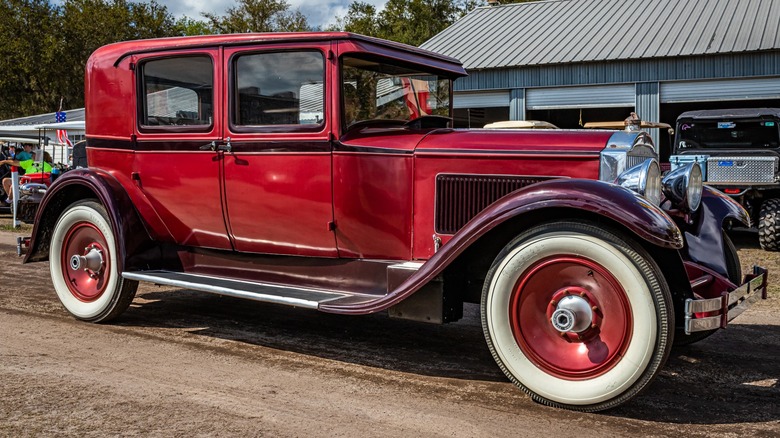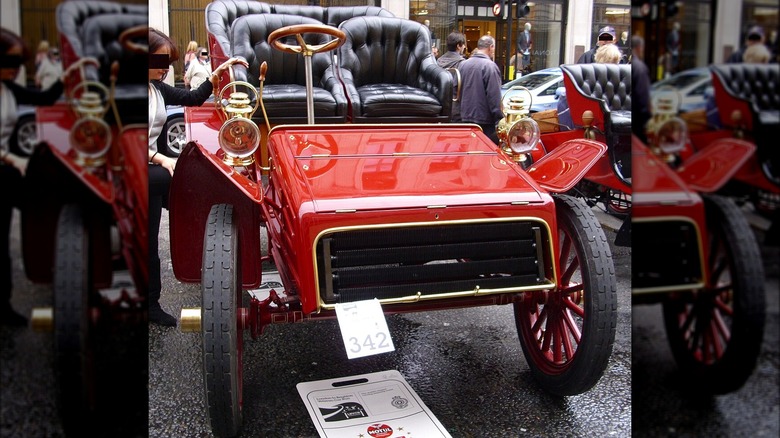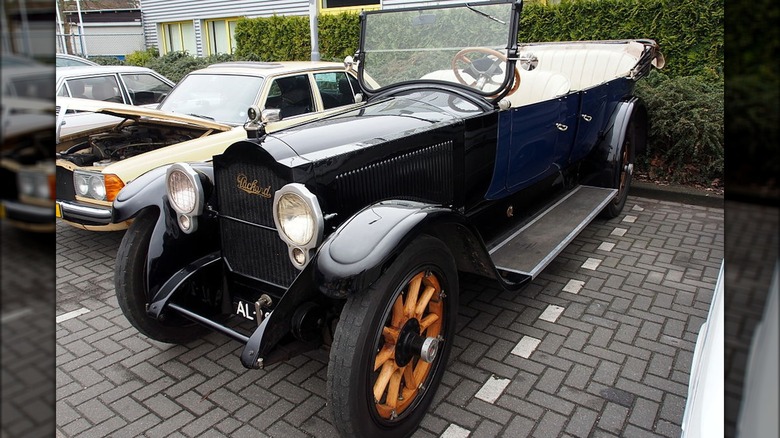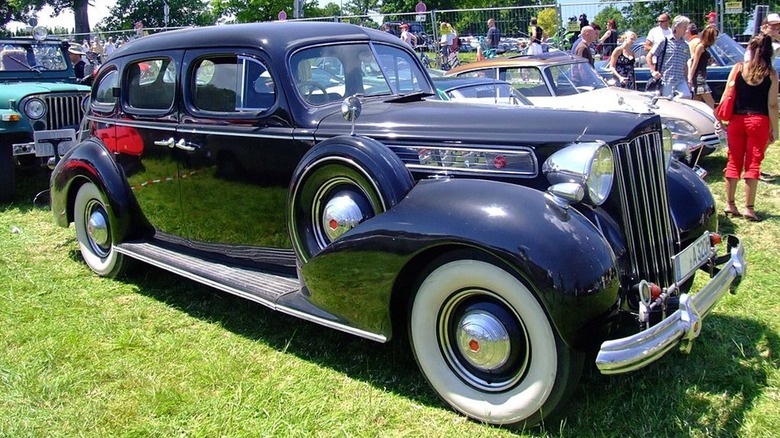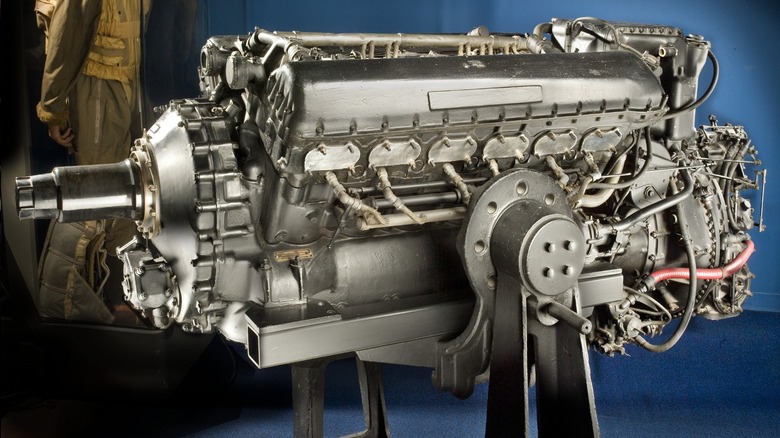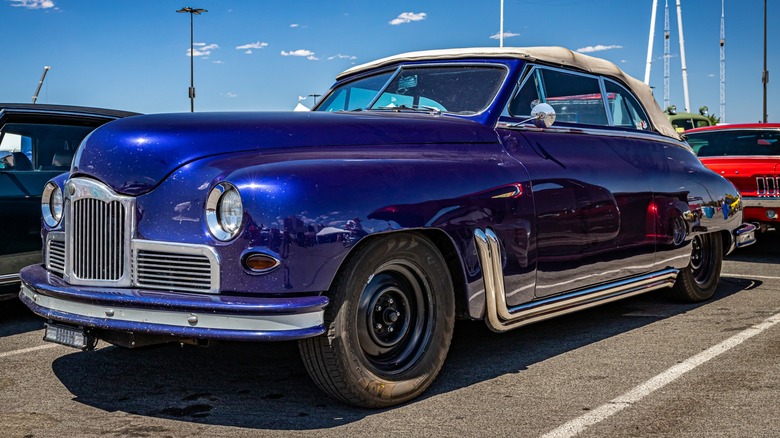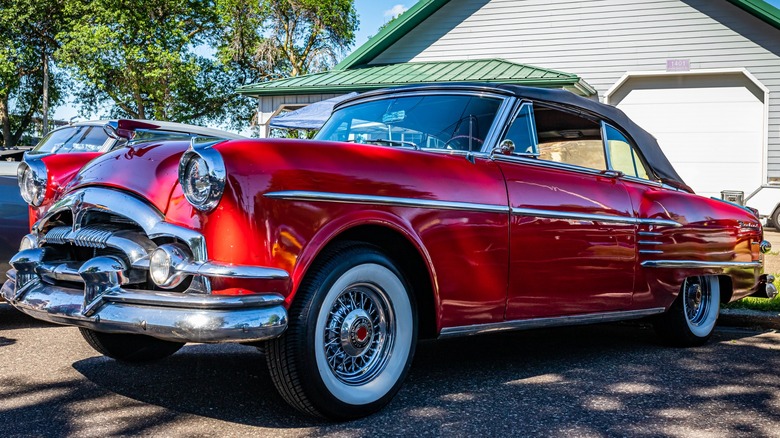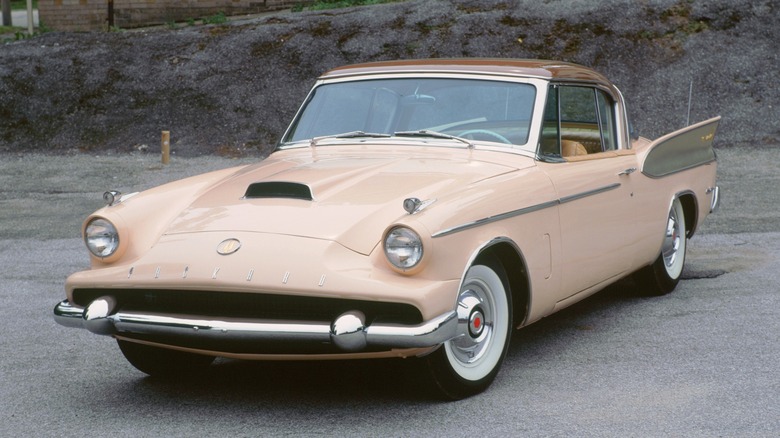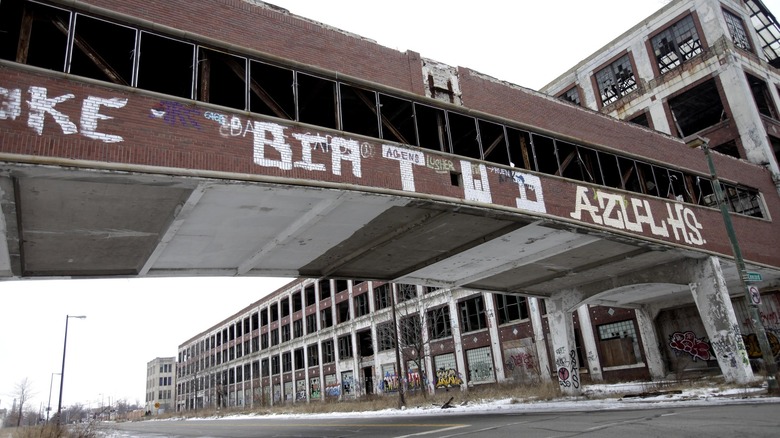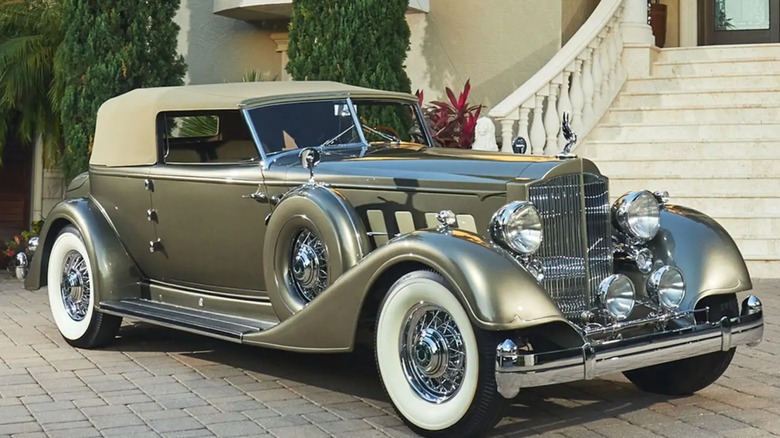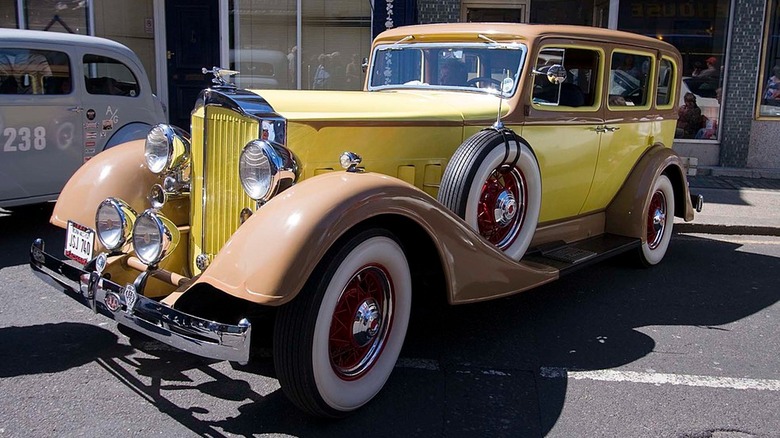Whatever Happened To The Packard Motor Company?
Dominating the American automotive landscape are the big three from Detroit: Ford, General Motors, and Chrysler. Then there are the smaller rivals who enjoy varying degrees of success, such as Tesla and Rivian. This has been the case for most of the post-war period, but in the early part of the 20th century, America had dozens of car companies vying for dominance. Most of them failed to leave much of an impression on the American automotive landscape, but some now-defunct carmakers made a significant impact in their time. One of these was Packard.
While it has not made cars for many decades, Packard was once known for making the finest, most opulent motorcars, destined for the garages of bankers, industry barons, Hollywood A-listers, and literal royalty. Cars built for the well-heeled must be lavish in their appointments, generous with their power delivery, and engineered for excellence. Packard delivered on these at a time when the mark of a luxury car was not how many power options the manufacturer could offer, but the degree of exclusivity of the materials used to build it. The company was once confident of this, as its advertising slogan was, "Ask the man who owns one." New Packards have not existed for some time, making it a bit harder to ask someone who owns one, but you still may ask, "Whatever happened to Packard?" Here is a brief recounting of the brand's story.
Packard origins
Mirroring many company origin stories, the Packard Motor Car Company arose as a result of James Ward Packard's suggestions to the maker of a car he owned, which had required constant repairs, being ignored. Months later, he joined his brother, William Doud Packard, with other backers to found a new company to build a better automobile. The first car was completed by the end of 1899, and by 1900, serial production was underway.
The excellent build quality of early Packards impressed customers, quickly increasing demand and fueling rapid growth. An heir to a railroad fortune, Henry B. Joy, bought two cars after seeing them at the 1901 National Auto Show, and also bought shares in the company. By 1902, Packard was building its Model K with a 24-horsepower engine while demand increased — production reached 10 cars per day that year. At the same time, a stock offering was made to raise $250,000 for expansion. H.B. Joy led a group of investors from Detroit in buying $150,000 of stock, effectively taking control of the company.
Shortly after losing control of his own company, J.W. Packard tendered his resignation, while his brother went back to running their previous business. While H.B. Joy talked J.W. Packard into returning, his tenure would be short. H.B. Joy bought land in Detroit and built a sprawling modern automotive plant on 66 acres, moving Packard from Ohio. While J.W. Packard remained president, he returned to Warren, Ohio, having no more active role in the company.
Early Packard innovations
From the start, Packard cars were known for quality as well as innovation. In 1899, a Packard implemented the first H-pattern shifter, and two years later became the first car with a steering wheel instead of a tiller. Also in 1899, Packard created the first automatic spark advance, and then broke the American speed record in 1904. Other innovations include the first 12-cylinder, hypoid differential, hydraulic shock absorbers, and power hydraulic brakes.
Packard began with single-cylinder models but quickly developed four-cylinder engines. A six-cylinder was introduced in 1912, and the rate of growth and innovation led the company to market the first automotive V12 by 1916 in the Packard Twin Six. The early reputation for quality gave way to a reputation for luxury as Packards of the '10s and '20s grew larger, more powerful, and increasingly opulent. People bought big V12 Packards for their quality, size, and power, but also as a status symbol. Packards of this era were highly desirable to people of means. With the incredibly smooth V12, buyers had their chassis sent to coachbuilders for custom bodies made to order in a variety of body styles, from coupelets to limousines. Buyers included oil-rich Osage Indians, Csar Nicolas of Russia, and the Emperor of Japan. At a time when a Ford Model T cost as little as $265, Packards sold from $3,000 to $5,000. To put it simply, the Packards of the Roaring Twenties were perhaps the best way of flaunting the excessive wealth produced in the era. They were the best.
Packard during the Depression
With the crash of the stock market in 1929 and the financial fallout following it, things looked bleak everywhere. Initially, Packard's tactic for survival was to build even more expensive and opulent cars to cater to the end of the market that would never struggle with finances, even during a deep depression. This strategy eventually started to show some cracks, as Packard's finances trended toward a precarious position. Although Packard built some of its most alluring and elegant models (that have since become timeless collectibles) in the early '30s, its 1935 One-Twenty model is what saved the company from going under.
While the typical price of a Packard started at $2,425, the One-Twenty retail price of $980 made it the first affordable Packard ever. Despite the low price, it remained a Packard, with good quality and attractive styling, but it came in at a price affordable to the affluent who were feeling the squeeze on their finances from the Depression. Packard continued to sell its most luxurious hand-crafted and coachbuilt models, but soon moved far more of these affordable Packards, allowing the company to survive the Depression while all other independent American luxury automakers, including Peerless, Marmon, and Pierce-Arrow, folded. This kept the company alive and well heading into WWII.
Packard wartime production
After the Japanese bombing of Pearl Harbor in 1941, the United States prepared for war. Like every other American car company, Packard ceased building passenger cars in favor of military production. The last Packard passenger car was built on February 9, 1942, and the vast factory was retooled to produce the Rolls-Royce Merlin engine for fighter planes and boats.
Packard had done this before when it designed and built the Liberty 12 engine that powered planes during WWI. This time, Packard received designs from Rolls-Royce and had to modify them for an American production line. The factory had recently been expanded and dozens of new auto assembly machines sat outside covered up and waiting for the next time civilian production would occur. Every part of the plant was converted to build aviation and marine engines, both of which were extraordinarily complex machines with more than 10,000 parts each, including high-precision components built to strict tolerances. Packard devised a new testing facility to ensure the reliability of its engines. Before shipping them out, each engine was run under load for six hours, and if it passed, it was disassembled, cleaned, and reassembled, assuring reliability in the heat of battle.
By the time the war ended, Packard employees, about half of whom were women, produced about 70,000 engines for the war effort. They proved invaluable assets that assisted the troops in defeating tyranny with utter reliability.
Post-war Packard
Before WWII, Packards were undoubtedly the epitome of American class and luxury. Though a more affordable model had been introduced, opulent exercises in largesse remained a part of the business. Packard played a huge role in getting the Allies through WWII, but it seems something got lost in trying to pick up where they left off. The Packards coming off the line starting in 1946 were essentially the same cars from 1942 when wartime production began. Only in 1948 would a new Packard arrive, but it was not warmly received. These cars resembled an upside-down bathtub more than an elegant luxury car. Packard started to slip.
With everyone else offering automatic transmissions, Packard was behind the pack. Rather than purchase proven units from a larger manufacturer, Packard developed its own, the Ultramatic. While it was successful, it was also a costly development at a time when the company's finances were not stable.
The first all-new Packard design came in 1951 with the 250, available as a convertible or the hardtop Mayfair. This was an attractive and modern car that still came up short. The new Ultramatic transmission was only a two-speed and it sat behind Packard's old flathead straight-8 engine, while OHV V8 engines sprang up all around it. Packard sold 100,000 units in 1951, but its numbers fell dramatically over the next couple of years, putting Packard in peril.
The Studebaker-Packard Corporation merger
A merger between an auto manufacturer known for making high-end luxury cars and another known for more affordable, mainstream models sounds on the surface like it should work. No doubt the leaders of Packard and Studebaker felt like this, but things never worked out so well for either. Both companies were struggling to keep up in the rapidly changing world of post-war auto manufacturing and losing market share to the industry giants, particularly GM.
Before the war, Packard had switched its body manufacturing to Briggs Manufacturing in a bid to save money. The savings weren't realized as Briggs raised prices, and Packard soon realized it had ended up more costly than before. This came to be an even bigger blow in 1952, when Chrysler bought Briggs with an agreement to continue supplying bodies to Packard only through 1954. The merger in 1954 was supposed to help with these troubles, but Packard CEO James Nance found out only after the merger was complete that Studebaker's financial troubles had been hidden from Packard throughout the merger process and both companies were hemorrhaging money.
After the merger, Packard was in a worse position financially than before, and was also forced into a smaller factory with poor working conditions. This was a costly move that lowered quality, a long-time Packard hallmark. By 1955, nothing seemed to be going right for Packard.
A fast decline
Post-war Packard was behind the curve in developing new car designs: It was late offering an automatic transmission, and it was still using an old straight-8 engine all the way until 1955. Furthermore, the landscape for luxury automakers was rapidly changing and the ultra-luxurious coachbuilt cars of the '30s were no longer in vogue. Mass production techniques had improved, enabling Cadillac, for example, to churn out fine luxury sedans by the thousands. Add to this a disastrous merger, and the outlook for Packard was grim.
A new Packard debuted in 1955, now with a new OHV V8 engine. In fact, the 1955 to 1956 Patrician sedan was an elegant large sedan packed with modern features and a plush interior. With up to 290 horsepower, a new torsion bar suspension, and updated styling, this could have been a successful model for Packard. It wasn't. Packard's problems had compounded to the point that after 1956, all Packard models were nothing but rebadged Studebakers.
For 1957 and 1958, the Packard name carried on with the Packard Hawk and the Packard Clipper. These were nothing more than a Studebaker Hawk and President. There was also a wagon version of the Clipper based on the Studebaker Broadmoor. These also received the Studebaker V8, although a supercharged version with 275 horsepower was available. Only 7,431 of these cars were sold for both years and in 1959, Packard automobiles ceased production altogether.
The historic Packard factory
Back in 1903, Packard received a new home in Detroit in what was then the largest auto manufacturing facility in the world. It continued to house Packard for a half-century through several expansions until it took up 3.5 million square feet on a 40-acre campus. At its peak, 41,000 employees worked at the Packard plant during WWII. With the decline of the Packard brand, employment fell steadily until auto production ended in 1957.
The plant was sold in 1958 and leased to 39 companies, although occupying half of the property. The number of tenants grew to 87 by the '90s, but that is when legal troubles plagued the property. Unpaid property taxes, foreclosure, lawsuits, and changing ownership led to a steady decline of the property. Demolition of part of the plant commenced in 2000 but was halted by a court order as part of a dispute between the owner and the city.
The owner ended up in prison for selling ecstasy and by the time he got out in 2010, the plant had been taken over by vagrants and vandalism. The fire department stopped responding to the many fires because of warnings of hazardous structural conditions. It had become one of the largest abandoned properties in the world and a glaring example of Detroit's problem with blight. It was an eyesore and a hazard, and it seemed nothing could be done with it. However, the city eventually seized the property and began demolishing the structures in 2022, completing demolition a year later and closing the final chapter on the Packard Motor Car Company.
Packards today
The opulent Packards of the pre-war era are among the most collectible cars in the world today. This is particularly true of the coachbuilt models custom-designed and built to order for the most affluent customers in the world. Some of the most stately and elegant Packards come from the Depression era, when Packard catered to the highest end of the market before introducing a low-cost car. A stunning example of this period was sold at Amelia Island by RM Sotheby's in 2022. The 1934 Packard Twelve Individual Custom Convertible Victoria from the estate of Frank Ricciardelli is one of three surviving cars and in impeccable condition. Powered by the famous Packard V12, it sold for $4.1 million, making it among the most valuable Packards ever.
Other classic Packards can be obtained for significantly less than $4 million, but they still won't come cheap. A similar but less exclusive 1933 Packard Twelve sold at Bonhams in 2023 for $387,250, a more typical price for cars of the era in immaculate condition. Conversely, anyone who wishes to own a Packard on a budget can look for those built after WWII. Packards of this era listed on Bring a Trailer can be found sold for as little as $5,600 for one that needs a little attention. Others in good condition can still be found for less than $20,000, which shows just how much Packard declined toward the end.
A Packard revival
With such a storied name as Packard, you might think that someone would try to bring the name back and rekindle its glory. Attempts have been made. For those who love the classic looks of a Packard but are not so fussy about having all original parts, Gibbons Fiberglass once offered fiberglass replica bodies that could be fitted to the frame of your choice, resulting in cars looking very much like a Packard, powered by something like a Chevy Small Block V8.
C. Budd Bayliff bought the rights to Packard and used it in the early '80s to customize GM vehicles such as the Buick Riviera in the style of classic Packards. These were essentially just gussied-up GM models that were more tacky than elegant. Again in 1992, Roy Gullickson bought the Packard name with plans of a proper revival with an all-new car to wear the Packard name. He built a prototype based on a bespoke chassis with an all-aluminum body powered by a V12 from Falconer Racing Engine. It was the only one.
The latest attempt is coming from Ohio, Packard's original home, and began in 2019 when Scott Andrews bought the rights. Plans are underway to build exact copies of 1930s Packards, and they already have a showroom with a 1934 Packard replica on display. While details are worked out, the Packard name is being offered on a line of bespoke watches available from their website. Perhaps one day new Packards will be seen on the streets again.
[Featured image by Smudge 9000 via Wikimedia Commons | Cropped and scaled | CC BY 2.0]
